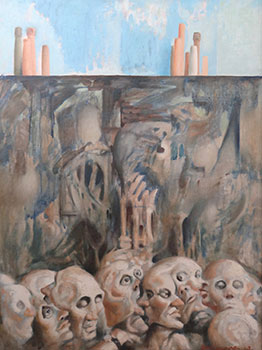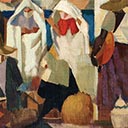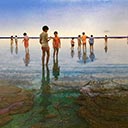Cuba Crisis
100 x 76 cm
Provenance: Purchased from the artist by the current owner , c. 1962
Exhibited: Edward Bullmore 1933-1978, Rotorua Art Gallery, 1979.
Edward Bullmore hailed from Balfour, Southland. He attended Canterbury University College, Christchurch, with Pat Hanly and Bill Culbert. Having taught at Tauranga Boys' College in the late 1950s he headed to Florence, with his wife and fellow artist, Jacqueline. The Bullmores spent six months in Italy and then in early 1960 relocated to London, staying until the end of 1969. During that time, Bullmoe taught at various art schools, and exhibited widely, attracting critical attention from the art world. Amongst collectors of his work from this era was filmmaker Stanley Kubrick, who featured two of Bullmore's works in A Clockwork Orange (1971). Begun in late 1962 and completed in 1963, the Cuba Crisis Series consists of seven works - some are paintings whereas others combine painting and collage. Upon arriving in London, Bullmore's work almost instantly began to reflect contemporary events and sentiments of a world threatened by nuclear war. Described as 'nuclear paranoia', Bullmore was swept up with the feeling of the unknown and fearful of what the future might bring. He was not alone; on April 18 1960, 100,000 people gathered in Trafalgar Square to protest against the 'H' bomb. More specifically, against the backdrop of the Cold War, the Cuban Missile Crisis (16-28 October 1962) saw a confrontation between the Americans and Soviets over the former's ballistic missile deployment in Italy and Turkey, with consequent Soviet ballistic missile deployment in Cuba. The threat of nuclear warfare was very real. In this work, Bullmore depicts the atrocities of what he imagined a nuclear war could look like. In the foreground, skulls fuse together as if melted or nuked; people have lost their individuality and identity, becoming mere statistics as a result of nuclear warfare. The middle ground, a drop cloth acts as a screen containing mysterious gloomy shapes. Smokey in colour and giving the appearance of shadows, is this the aftermath of a war-torn cityscape? The ambiguity around some elements typifies this series and is symbolic of a population poised, unsure of the future. Rising in the background are two groups of chimneys - they could be industrial but are more likely to represent death chambers. The blue sky offers a small glimmer of hope for humankind. This work, as indeed the entire series, is raw and dark in subject matter. It is evocative of a worried man, father, husband and artist. Bullmore had travelled to London to informally further his art education but what he found was a city fearful and attuned to war. The great distance from Southland, New Zealand, was never far from his mind. Surreal in their content, this series of works were painted with sharp and detailed rendering. The tight and ordered compositions are very much indebted to his formal New Zealand art education. Stylistically more surreal than anything he painted to date, the Cuba Crisis Series called on such antecedents as Picasso's Guernica and Dali's grotesque forms in Boiled Beans and Skeletons of Bishops. Bullmore also explored new ways of combining materials in this series by including collage. By not using materials in the conventional manner, Bullmore created rawness, aligned with his thinking of the time. In other works from the series, vertical strips of roughly ripped canvas allude to the disfigurement and double as bandages. Bullmore spent a decade in London where he taught and exhibited. He made his solo debut at London's Tama Galleries, with his shaped canvases, and later in 1967 in Exeter exhibiting in a Surrealist exhibition, The Enchanted Domain. Bullmore returned to New Zealand in late 1969 taking up a teaching position at Rotorua Boys' High School. The Cuba Crisis Series offer scenes of morbidity - grotesque and raw both in subject and how Bullmore executed them. It was not until Bullmore reached London that political crises affected his art and thus changed his way of seeing the external world, and most particularly the landscape. The contrast of a nuked environment compared with New Zealand's clean and green image was vast. Penelope Jackson
For more information on this piece, please download this PDF (50KB)





